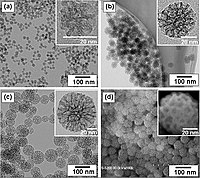
Photo from wikipedia
Abstract In the present study, a classification system of four meteorological indices were introduced to classify the sky types from sunny to cloudy. These meteorological indices are; cloud cover (Cc),… Click to show full abstract
Abstract In the present study, a classification system of four meteorological indices were introduced to classify the sky types from sunny to cloudy. These meteorological indices are; cloud cover (Cc), sunshine hour (S), clearness index (Kt) and diffuse fraction (K). Frequency of occurrence and cumulative frequency distribution of each sky indices were established to interpret the prevailing sky conditions in eight cases, each case investigates one day, these days were chosen according to the type of clouds that were overwhelming that day at a subtropical location in Turkey (Izmir). The impact of Cc, on measured global solar radiation (GSR) intensity were also analyzed. In order to predict GSR in each selected case and to making it more and more precise, NARX, FFNN and GRNN weather parameters-based models were evaluated and compared. To achieve accuracy of estimation, ten different input configurations were used to train the models. In addition global solar radiation in a cloudless skies (GSR’) is evaluated as a new input parameter. NARX models had the best performance for estimation of GSR in the first case, with GPI of 0.936 (NARX-C1M1). Results are also indicating that all NARX artificial neural network models provided better estimations than GRNN and FFNN models in case 2 with GPI value of 0.872 (NARX-C2M1). As for case 3, NARX was considered as the best models (NARX-C3M1, GPI = 0.957), followed by NARX (NARX-C3M6, GPI = 0.956) and then FFNN (FF-C3M1, GPI = 0.949). In case 4, NARX models had the highest GPI value (NARX-C4M1, GPI = 0.957) compared with FFNN and GRNN indicated models. Regarding case 5, NARX was considered as the best network (NARX-C5M4, GPI = 0.748), followed by NARX-C5M9 (GPI = 0.549), while FFNN and GRNN model couldn't provide positive results. Likewise, the NARX models did provide better results in case 6 with best GPI value up to 0.64. Furthermore, only NARX and FFNN models provided the better estimation in case 7 (best model, NARX-C7M1 with GPI = 0.826), whereas, GRNN models did not give such acceptable results. Similar to the mentioned above and in comparison with FFNN and GRNN, we have deducated that NARX models offered a better accuracy results compared with the other models (best model, NARX-C8M4 with GIP = 0.364) in case8.
Journal Title: Measurement
Year Published: 2021
Link to full text (if available)
Share on Social Media: Sign Up to like & get
recommendations!